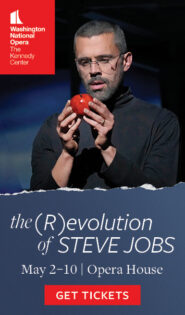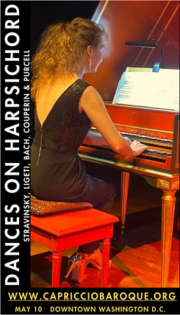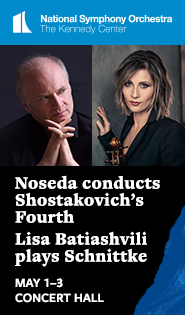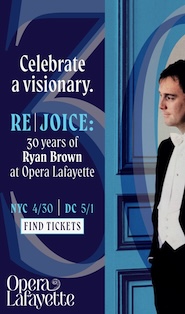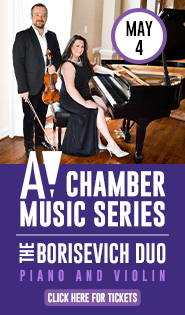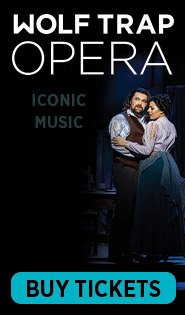Wolf Trap’s stylish “Silent Night” revisits the opera’s film origins
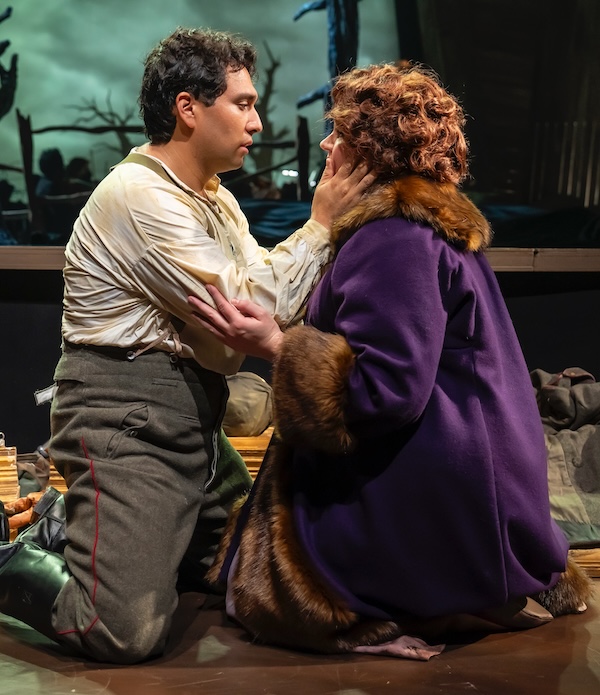
Ricardo Garcia and Keely Futterer in Kevin Puts’ Silent Night at Wolf Trap Opera. Photo: Scott Suchman
New operas need multiple stagings to thrive and find their place. Wolf Trap Opera admirably takes risks on recent or underexposed works as part of its programming formula most summers. The plucky company assembled a cast of accomplished young artists to conclude its season with a cinematic new production of Silent Night, the first opera by Baltimore-based composer Kevin Puts, seen Friday evening in The Barns.
After winning the Pulitzer Prize for Music in 2012, this powerful work has reached multiple stages, including being mounted by Washington National Opera in 2018. Mark Campbell’s multilingual libretto, adapted from the 2005 film by Christian Carion, reimagines an actual event, the visit of a celebrated German opera singer to the front lines of World War I in December of 1914. As actually happened in the trenches that year, soldiers from Scotland, France, and Germany agree on a brief cease-fire to celebrate Christmas Eve together.
The process of operatic adaptation usually involves streamlining, but Campbell and Puts kept and even expanded the film’s plethora of characters and storylines. A Scottish painter enlists with his beloved brother, only to lose him shortly before the Christmas truce. A French lieutenant, son of a leading general, has to leave his wife, who is expecting their child. His aide is shot by the Scottish soldiers while in disguise to visit his mother in a nearby town. The Scottish and French generals and the German crown prince crack down on the fraternization among their soldiers.
The complexity of the interlocking plots and the long cast list mean that much of the score is devoted to ratatat dialogue, some of it even spoken, rather than lyrical arias. One exception is the central role of Anna Sørensen, the Danish opera singer and fiancée of the German singer, Nikolaus Sprink. Soprano Keely Futterer brought remarkable vocal grace to the character, rendering her unaccompanied “Dona nobis pacem,” sung at the impromptu Mass on Christmas Eve, with buttery opulence, up to a crystalline C sharp.
Ricardo Garcia made an earthy, fiery Sprink, at his best in the imitation-Mozart duet the character sings with Sørensen. His potent tenor carried well in this challenging role, giving out only briefly at the apex of his angry rant against his commander in Act II. Baritone Andrew Gilstrap, noteworthy for his gruff Leporello last season, brought vocal heft to the role of the conflicted Lieutenant Horstmayer, matched by the somewhat unhinged crown prince of tenor Demetrious Sampson, Jr.
On the French side, Jacob Scharfman plied his silky baritone to the aria of Audebert, the dapper French lieutenant missing his pregnant wife. His servant, the sweet-hearted barber named Ponchel, received a pleasing interpretation by baritone Charles H. Eaton, appealingly nerdy and sentimental. Chinese bass Le Bu, who was a tender Colline in this summer’s La Bohème, turned on scorching vocal power as the French General.

Jacob Scharfman and Andrew Gilstrap in Silent Night at Wolf Trap Opera. Photo: Scott Suchman
Tenor Martin Luther Clark, returning to Wolf Trap after a year as a Studio Artist in 2014, gave an emotionally powerful performance as Jonathan Dale, the Scottish soldier who loses his brother. Bass Wm. Clay Thompson capped an extraordinary two seasons at Wolf Trap with a puissant turn as Father Palmer, the Scottish chaplain. Ryan Wolfe brought a brusque baritone and the most convincing of the cast’s Scottish brogues to the role of Lieutenant Gordon.
Relegated again with the orchestra to the back of the stage, conductor Geoffrey McDonald kept the large cast mostly on track, extending his run of Wolf Trap appearances. He led a trimmed-down version of Puts’ full orchestration of the opera, rather than the reduction by Jacques Desjardins heard at Washington National Opera. According to Wolf Trap’s Lee Anne Myslewski, Wolf Trap used a new version of the opera by Puts and Campbell, who “punched up parts of the piece,” but with smaller numbers of winds, brass, and percussion “so that it will fit in our space.”
Bass-baritone Ryan McKinny and his wife, Tonya McKinny, returned to Wolf Trap this time as stage directors, building on their experience working together to create operatic films. The house space in front of the stage became the trenches, with vivid combat scenes in the no man’s land in the downstage area. The creative use of a scrim with elaborate video projections (designed by Adam Larsen) served for the non-war scenes, as well as providing close-ups of various singers, often in silent dialogue with scenes on stage.
A skewed framing of the proscenium (scenic design by Lawrence Moten) added to the sense of disequilibrium in the early months of the Great War, punctuated by violent fights, shocking gunshots, and simulated mustard gas and explosions (lighting design by Colin K. Bills). Costumes (by Lynly Saunders) helped to distinguish the three armies visually, especially helpful in the complicated tri-choral scenes composed by Puts, sung with virile power by the male ensemble. Special kudos to bagpiper Matthew Harriman and harpist William Richards, who added signature elements to the opera’s tapestry of sound.
Silent Night runs through August 17. wolftrap.org

Photo: Scott Suchman
